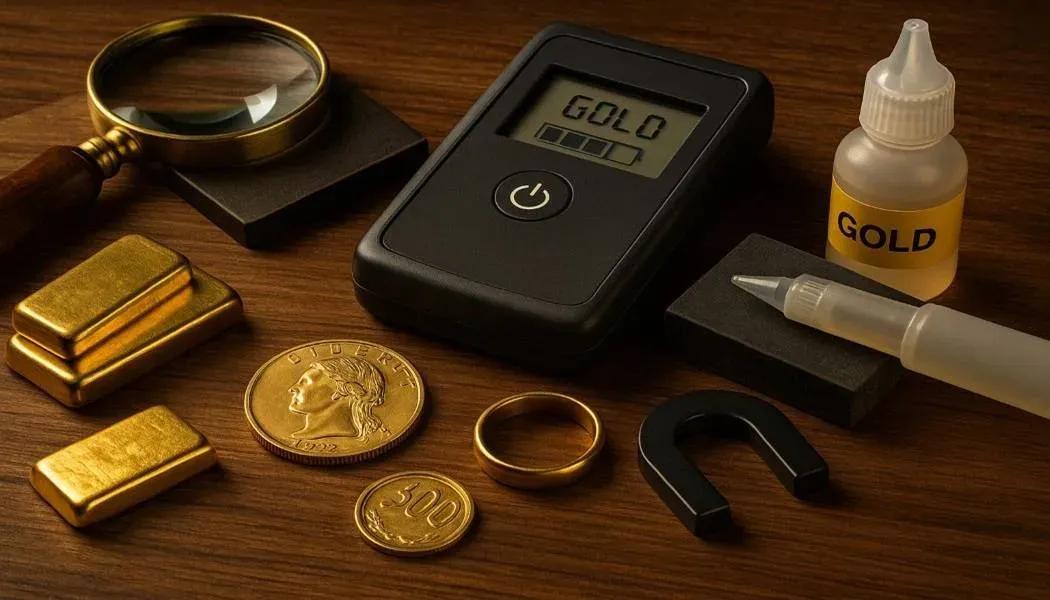How to Test Gold at Home: Reliable Methods Explained

Why Testing Gold at Home Matters
Gold has been trusted for centuries as a store of value and a symbol of wealth. For today’s collectors, investors, and jewelry owners, verifying authenticity is more important than ever. Counterfeit and plated pieces are increasingly common, and distinguishing genuine gold from imitations can protect your financial security. While professional assays deliver the highest accuracy, there are several proven methods you can perform at home to help confirm the purity of your coins, bars, or jewelry.
1. Inspect for Hallmarks and Stamps
A careful inspection is the easiest starting point. Authentic gold items usually display hallmarks indicating their fineness, such as 10K, 14K, 18K, or 24K. These markings may also include a manufacturer’s logo, mintmark, or country of origin. However, be alert for misleading markings:
🔹 GP, GF, or HGP mean gold plated, gold filled, or heavy gold plate.
🔹 925, 950, or 800 signal silver alloys rather than gold.
Because forgeries are common, hallmarks should be viewed as a preliminary check rather than final proof.
2. The Magnet Test: A Simple First Filter
Gold is not magnetic, which makes a magnet test a convenient early step. Hold a strong magnet—ideally a neodymium magnet—next to the piece. If it sticks, the item contains other metals and is not pure gold. Keep in mind, though, that some counterfeiters use non-magnetic alloys, so while this test is quick, it cannot confirm authenticity on its own.
3. Ceramic Scratch Test: Color Reveals Clues
Another method is the ceramic test. By rubbing the gold against an unglazed ceramic plate, you can examine the streak it leaves. Genuine gold produces a yellow streak, while imitations leave gray or black lines. Use this method carefully, as it can scratch delicate or decorative items, and is best reserved for pieces without high aesthetic or sentimental value.
4. Density Test: Science You Can Do at Home
Gold is one of the densest metals, with a standard density of 19.3 g/mL. To test this:
1. Weigh the item on a precise scale.
2. Submerge it in water to measure volume displacement.
3. Divide weight by volume to calculate density.
If the result is close to 19.3 g/mL, the item is likely pure gold. This method works best on solid, simple shapes rather than ornate or hollow designs.
5. Acid Testing: A Traditional Standard
For centuries, jewelers have relied on acid testing to check gold. Test kits come with different acid solutions matched to various karat levels. Rub the item against a test stone and apply the acid to the streak. Pure gold resists the reaction, while lower purity or fake metals discolor or dissolve. Always handle acids with care—use gloves, goggles, and proper ventilation.
6. Electronic Gold Testers: Fast and Non-Destructive
Modern electronic devices make gold testing faster and safer. These testers measure the metal’s electrical conductivity, which is unique to gold. They provide quick, accurate results without damaging the item. Electronic testers are ideal for regular buyers, sellers, and collectors who want a dependable tool for frequent verification.
7. X-Ray Fluorescence (XRF): The Professional Benchmark
For the highest level of accuracy, X-Ray Fluorescence (XRF) analysis is the industry standard. This non-destructive technology identifies the exact elemental composition of a piece in seconds. Though typically available through professional dealers or jewelers, XRF testing is invaluable for high-value coins, bullion, or heirloom jewelry where certainty is essential.
Choosing the Right Testing Method
The most effective approach is to use multiple methods in combination. Begin with easy checks like hallmarks and magnets, then apply more advanced techniques such as density, acid, or electronic tests for confirmation. For high-stakes gold purchases or large investments, professional verification adds peace of mind.
The Importance of Gold Verification
Whether you’re adding to a collection, buying investment-grade bullion, or evaluating inherited jewelry, testing gold at home empowers you with confidence. By blending traditional methods with modern technology, you can safeguard your wealth and ensure that every piece you own is genuine. In the world of precious metals, authenticity is everything—and trust begins with proper verification.